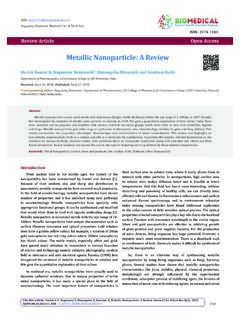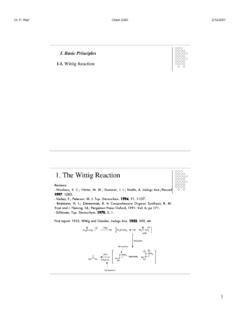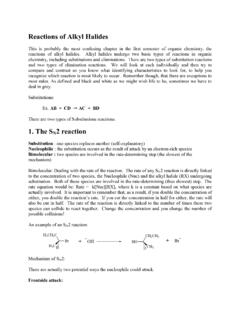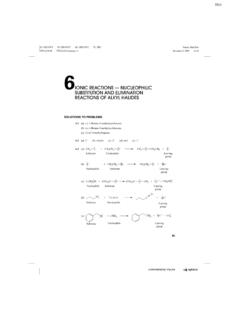Transcription of Zeta potential - An introduction in 30 minutes
1 TECHNICAL NOTEM alvern Instruments WorldwideSales and service centres in over 65 2015 Malvern Instruments LimitedZeta potential - An introduction in 30 minutesZETA POTENTIALI ntroductionZeta potential is a physical property which is exhibited by any particle in suspension,macromolecule or material surface. It can be used to optimize the formulations ofsuspensions, emulsions and protein solutions, predict interactions with surfaces, andoptimise the formation of films and coatings. Knowledge of the zeta potential canreduce the time needed to produce trial formulations. It can also be used as an aid inpredicting long-term measurement of macromolecule charge, or more specifically protein charge,requires a very sensitive system, such as the new Zetasizer ZSP, and a technique toreduce the sample volume requirement, and avoid sample degradation. This systemand technique are described in measurement of the zeta potential of surfaces requires an accessory for theZetasizer Nano, and the subject and accessory are described separately in introduction concentrates on the zeta potential of colloidal systems, with a densitylow enough such that if they remain dispersed, sedimentation is ScienceThree of the fundamental states of matter are solids, liquids and gases.
2 If one of thesestates is finely dispersed in another then we have a 'colloidal system'. These materialshave special properties that are of great practical are various examples of colloidal systems that include aerosols, emulsions,colloidal suspensions and association certain circumstances, the particles in a dispersion may adhere to one anotherand form aggregates of successively increasing size, which may settle out under theinfluence of gravity. An initially formed aggregate is called a floc and the process ofits formation flocculation. The floc may or may not sediment or phase separate. Ifthe aggregate changes to a much denser form, it is said to undergo coagulation. Anaggregate usually separates out either by sedimentation (if it is more dense than themedium) or by creaming (if it less dense than the medium). The terms flocculation andTECHNICAL NOTE2 Zeta potential - An introduction in 30 minutescoagulation have often been used interchangeably. Usually coagulation is irreversiblewhereas flocculation can be reversed by the process of deflocculation.
3 Figure 1schematically represents some of these 1: Schematic diagram showing various mechanisms where stability may be lost in a colloidal dispersionColloidal Stability and DVLO TheoryThe scientists Derjaguin, Verwey, Landau and Overbeek developed a theory in the1940s which dealt with the stability of colloidal systems. DVLO theory suggests that thestability of a particle in solution is dependent upon its total potential energy function theory recognizes that VT is the balance of several competing contributions:VT = VA + VR + VSVS is the potential energy due to the solvent, it usually only makes a marginalcontribution to the total potential energy over the last few nanometers of more important is the balance between VA and VR, these are the attractive andrepulsive contributions. They potentially are much larger and operate over a muchlarger = -A/(12 D2)where A is the Hamaker constant and D is the particle repulsive potential VR is a far more complex = 2 a 2 exp(- D)TECHNICAL NOTE3 Zeta potential - An introduction in 30 minuteswhere a is the particle radius, is the solvent permeability, is a function of the ioniccomposition and is the zeta theory suggests that the stability of a colloidal system is determined by the sumof these van der Waals attractive (VA) and electrical double layer repulsive (VR) forcesthat exist between particles as they approach each other due to the Brownian motionthey are undergoing.
4 Figure 2a shows the separate forces as a dotted line, and thesum of these forces as the solid line. This sum has a peak, and the theory proposesthat particles that are initially separated are prevented from approaching each otherbecause of the repulsive force. However if the particles are forced with sufficientenergy to overcome that barrier, for example by increasing the temperature, theattractive force will pull them into contact where they adhere strongly and 2(a): Schematic diagram of the variation of free energy with particle separation according to if the particles have a sufficiently high repulsion, the dispersion will resistflocculation and the colloidal system will be stable. However if a repulsion mechanismdoes not exist then flocculation or coagulation will eventually take the zeta potential is reduced ( in high salt concentrations), there is a possibility ofa "secondary minimum" being created, where a much weaker and potentially reversibleadhesion between particles exists (figure 2 (b)).
5 These weak flocs are sufficientlystable not to be broken up by Brownian motion, but may disperse under an externallyapplied force such as vigorous NOTE4 Zeta potential - An introduction in 30 minutesFigure 2(b): Schematic diagram of the variation of free energy with particle separation at higher saltconcentrations showing the possibility of a secondary to maintain the stability of the colloidal system, the repulsive forces mustbe dominant. How can colloidal stability be achieved? There are two fundamentalmechanisms that affect dispersion stability (figure 3):Figure 3: steric and electrostatic stabilization mechanisms of colloidal dispersions steric repulsion - this involves polymers added to the system adsorbing onto theparticle surface and preventing the particle surfaces coming into close enough polymer adsorbs, the thickness of the coating will be sufficient to keepparticles separated by steric repulsions between the polymer layers, and at thoseseparations the van der Waals forces are too weak to cause the particles to NOTE5 Zeta potential - An introduction in 30 minutes Electrostatic or charge stabilization - this is the effect on particle interaction due tothe distribution of charged species in the mechanism has its benefits for particular systems.
6 steric stabilization issimple, requiring just the addition of a suitable polymer. However it can be difficult tosubsequently flocculate the system if this is required, the polymer can be expensiveand in some cases the polymer is undesirable when a ceramic slip is cast andsintered, the polymer has to be 'burnt out'. This causes shrinkage and can lead or charge stabilization has the benefits of stabilizing or flocculating asystem by simply altering the concentration of ions in the system. This is a reversibleprocess and is potentially has long been recognized that the zeta potential is a very good index of themagnitude of the interaction between colloidal particles and measurements of zetapotential are commonly used to assess the stability of colloidal of Surface ChargeMost colloidal dispersions in aqueous media carry an electric charge. There aremany origins of this surface charge depending upon the nature of the particle and itssurrounding medium, here we will consider the more important of Surface GroupsDissociation of acidic groups on the surface of a particle will give rise to a negativelycharged surface.
7 Conversely, a basic surface will take on a positive charge (figure 4).In both cases, the magnitude of the surface charge depends on the acidic or basicstrengths of the surface groups and on the pH of the solution. The surface chargecan be reduced to zero by suppressing the surface ionization by decreasing the pH incase of negatively charged particles (figure 4(a)) or by increasing the pH in the case ofpositively charged particles (figure 4(b)).Figure 4(a): Origin of surface charge by ionization of acidic groups to give a negatively charged surfaceTECHNICAL NOTE6 Zeta potential - An introduction in 30 minutesFigure 4(b): Origin of surface charge by ionization of basic groups to give a positively charged surfaceDifferential loss of ions from the crystal latticeAs an example, consider a crystal of silver iodide placed in water. Solution of ionsoccurs. If equal amounts of Ag+ and I- ions were to dissolve, the surface would beuncharged. In fact silver ions dissolve preferentially, leaving a negatively chargedsurface (figure 5).
8 If Ag+ ions are now added the charge falls to zero. Further additionleads to a positively charged 5: Origin of surface charge by differential solution of silver ions from a AgI surfaceAdsorption of charged species (ions and ionicsurfactants)Surfactant ions may be specifically adsorbed on the surface of a particle, leading, inthe case of cationic surfactants, to a positively charged surface (figure 6(a)) and, in thecase of anionic surfactants, to a negatively charged surface (figure 6(b)).TECHNICAL NOTE7 Zeta potential - An introduction in 30 minutesFigure 6(a): Origin of surface charge by specific adsorption of a cationic surfactant. R = hydrocarbon chainFigure 6(b): Origin of surface charge by specific adsorption of an anonic surfactant. R = hydrocarbon chainThe Electrical Double LayerThe development of a net charge at the particle surface affects the distribution ofions in the surrounding interfacial region, resulting in an increased concentration ofcounter ions, ions of opposite charge to that of the particle, close to the surface.
9 Thusan electrical double layer exists round each PotentialThe liquid layer surrounding the particle exists as two parts; an inner region (Sternlayer) where the ions are strongly bound and an outer (diffuse) region where they areless firmly associated. Within the diffuse layer there is a notional boundary inside whichthe ions and particles form a stable entity. When a particle moves ( due to gravity),ions within the boundary move it. Those ions beyond the boundary stay with the bulkdispersant. The potential at this boundary (surface of hydrodynamic shear) is the zetapotential (figure 7).TECHNICAL NOTE8 Zeta potential - An introduction in 30 minutesFigure 7: Schematic representation of zeta potentialThe magnitude of the zeta potential gives an indication of the potential stability of thecolloidal system. If all the particles in suspension have a large negative or positive zetapotential then they will tend to repel each other and there will be no tendency for theparticles to come together.
10 However, if the particles have low zeta potential values thenthere will be no force to prevent the particles coming together and general dividing line between stable and unstable suspensions is generally takenat either +30 or -30 mV. Particles with zeta potentials more positive than +30 mV ormore negative than -30 mV are normally considered stable. However, if the particleshave a density greater than the dispersant, even though they are dispersed, they willeventually sediment forming a close packed bed ( a hard cake).Thus it can be seen that as the zeta potential depends on the nature of the dispersantas well as the surface, The zeta potential of a particle must include the definition ofthe nature of the dispersant as well, if the zeta potential of different materials is to main parameters of the system are considered NOTE9 Zeta potential - An introduction in 30 minutesFactors Affecting Zeta potential (1) pHIn aqueous media, the pH of the sample is one of the most important factors thataffects its zeta potential .








